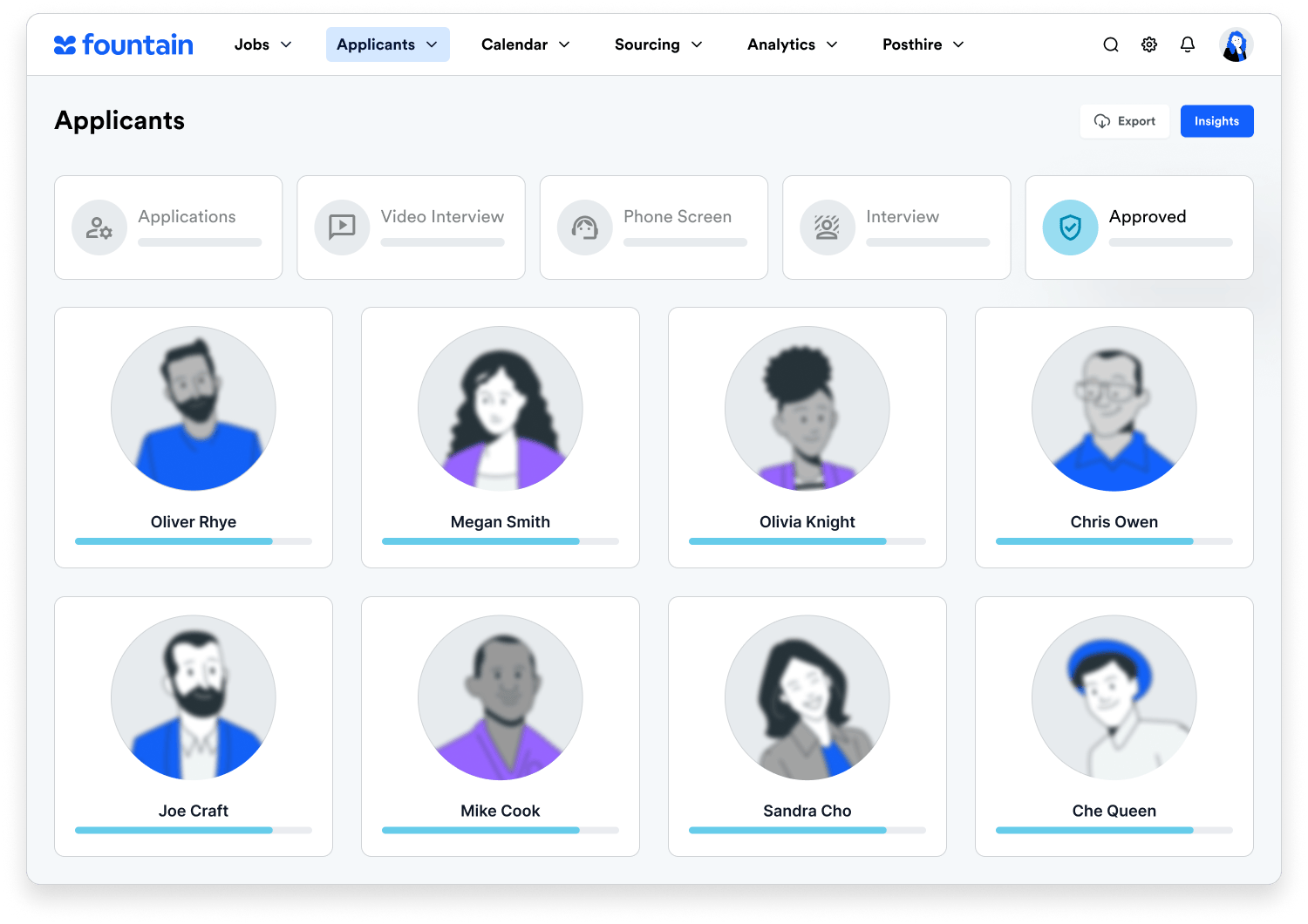If it feels like the world of recruitment is constantly changing, that’s because it is. We know it’s hard to stay on top of the trends, best practices, and advice from the powers that be, so we want to make it as easy as possible for you to make the best decisions for your organization’s hiring needs.
In this post, we’ll explore the challenges high volume recruiters face today, reveal opportunities for hiring process optimization, and wrap everything up with a clear, actionable, step-by-step guide to help you navigate the ever-changing hiring landscape.
High volume hiring explained
High volume hiring involves hiring for a large number of hourly job openings within a short period of time. This type of recruitment is often used by enterprise organizations across a variety of industries, including retail, hospitality, healthcare, and manufacturing.
The differences between high volume hiring and corporate recruiting are many, but here are just a few:
- Sourcing. Corporate recruiters typically source candidates on sites like LinkedIn or other mainstream job sites, while high volume hiring teams can use alternative sourcing methods like social media, in-store signage, and niche job sites.
- Communication. Email versus SMS and mobile messaging platforms are the clear differentiators between corporate and high volume hiring, respectively.
- Applications. Cover letters and resumes for corporate roles are a stark contrast from the simple, mobile-friendly applications that applicants can complete in a matter of minutes.
Motivators and challenges in high volume hiring
There are a few reasons why companies might need to adopt a high volume hiring process. For example, they may be on the brink of rapid expansion, or they may be experiencing unusually high turnover after a busy season. When these types of situations arise, hiring teams need to be prepared with a hiring system that can handle mass applications and help get roles filled quickly.
Manual processes are also a challenge in hourly hiring. From scheduling interviews to tracking applicant progress, many companies still rely heavily on manual tasks, which are time-consuming and prone to errors. This lengthens the overall hiring process, results in miscommunication or ambiguity with candidates, and creates a lack of visibility into the recruitment pipeline.
To overcome these challenges, it’s essential for companies to embrace new and innovative technologies that streamline and automate the hiring process, making it easier to find, assess, and hire top talent.

Step-by-step: The high volume hiring process
To hire new workers, there are specific steps you need to take to find out if they’re the right fit for the job and to ensure you’re compliant with legal labor laws. Implementing a well-constructed high volume hiring process is critical because if not done properly, you could face high turnover and wasted expenses. But predetermined hiring steps will make finding the right candidates more efficient and cost-effective.
See below for a step-by-step guide to building your most efficient high volume hiring process.
1. Determine your needs
Conduct an audit of your current positions and look for gaps that need to be filled. Next, align with the right people in your organization to get the sign-off to hire for these positions.
2. Develop and review your high volume hiring strategy
Gather your hiring team to discuss the best ways to hire for these open roles. If you have an existing strategy, take ample time to review it to see if any goals and tasks need to be added or removed, for example, replacing manual processes with automated ones.
Read more: 9 Ways to maximize your high volume hiring strategy
3. Write job descriptions
Your job description needs to be clear and to the point, while also including the details your ideal candidate will be scanning for. Explain what the new hire will be doing on a daily basis, what background they should have to be successful, and what benefits they may be privy to.
4. Post your job openings
With your job descriptions and strategy complete, it’s time to post your jobs to the right platforms, which may include free job boards or paid job boards. You can also tap into other sourcing methods like internal referrals and social media. If you use an applicant tracking system (ATS), it might take care of this task for you.

5. Review and screen applicants
Lean into the abilities of your ATS by activating knockout questions that automatically move candidates to the next stage or remove them from the process based on their responses to qualifying questions. When further evaluation is needed, you can step in and make manual changes to individual stages as needed.
6. Issue assessments (if applicable)
After you’ve screened the candidates, you may want to introduce an assessment stage to further determine whether individuals will excel in the role. Assessment types might include personality tests or practical skills tests. Assessment platforms like Lessonly or Northpass can be integrated with your ATS for easy administration and management.
7. Arrange interviews
Once you’ve received a quality group of candidates, you can initiate the interview process. Depending on your system and strategy, this can involve either in-person interviews, one-to-one video interviews, or even prerecorded interviews.
8. Conduct background checks
A background check is necessary to confirm the candidates’ identity, review criminal records, and learn more about their financial history. A high volume hiring process like the one provided by Fountain integrates with platforms like Checkr and Yardstik to make this step as seamless as possible.
9. Perform reference checks
In addition to background checks, you may also want to check your candidates’ references. Speaking with their past employers can give you insight into how they might perform at your company.
10. Hire and onboard
A comprehensive high volume hiring process culminates with the extension of a job offer and the start of the onboarding process. Send your new hire everything they’ll need to start the job, like handbooks and staff manuals, to help them prepare for their first day of work.
Need more onboarding guidance? Click here to check out our onboarding tips and checklists.
Tips for high volume hiring
Now that you’ve got your strategy in place, we’ve compiled a list of tips to optimize and customize your high volume hiring process for a fast track to exceptional results.
- Use automation to hire faster. Use automation to help you schedule interviews, trigger background checks, and keep candidates moving through the funnel.
- Enhance the candidate experience with frequent communication. The candidate experience is critical at every stage of the hiring process. Prioritize the candidate experience by providing clear and concise information about each step of the process, answering questions in a timely manner, and making it easy for candidates to apply and complete the necessary paperwork.
- Lean into data and analytics. Building an effective recruitment funnel for hourly workers requires a combination of smart hiring practices and an efficient tech stack. By using data to inform your approach, you can build a recruitment funnel that turns candidates into hires.

Tools for high volume hiring
You can’t adequately execute these strategies and test out these tips without the proper equipment. To fully implement automation, communication, and analytics in your high volume hiring process, here are a few tools you can rely on to get you up and running.
- ATS. Did you know? More than 98% of large companies use an ATS to hire. While you may not be a large company, you certainly have hiring needs on a grand scale that can be streamlined and simplified with the help of an ATS.
- AI. AI for hiring can drastically cut the time it takes to get candidates to the final stages by performing tasks that historically have slowed down the process for both recruiters and candidates.
- Mobile-first technology. Communication is of the utmost importance when hiring hourly workers because they’re likely to apply for multiple jobs at the same time. With mobile-first technology, you can reach them by text message to keep them engaged and provide them with important information about their application status.
- Video interviewing software. According to a survey, 63% of HR managers have used online video or video interviewing software as part of their recruitment process. Video interviewing software enables recruiters to carry out interviews when and where it’s most convenient.
How Fountain can help
We understand this may feel like a lot of work to build your ideal high volume hiring process, but we’ve got good news: We’re here to help!
Fountain’s easy-to-use platform guides candidates from apply to start date in just days. Customize your openings by location, access actionable insights with full visibility into data, and deliver a world-class application experience to each and every candidate.

